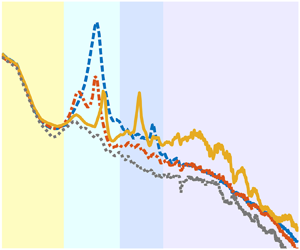Crossref Citations
This article has been cited by the following publications. This list is generated based on data provided by
Crossref.
Bai, Honglei
Lu, Zhenbo
Wei, Renke
Yang, Yannian
and
Liu, Yu
2021.
Noise reduction of sinusoidal wavy cylinder in subcritical flow regime.
Physics of Fluids,
Vol. 33,
Issue. 10,
Chen, Guanjiang
Liu, Xiao
Zang, Bin
and
Azarpeyvand, Mahdi
2022.
The effect of the splitter plate on the aeolian tone mitigation.
Li, Jiawei
Han, Xiaolei
Rinoshika, Hiroka
Li, Wenming
and
Rinoshika, Akira
2022.
Flow control of wake around a wall-mounted cube using a horizontal hole of different diameters.
Physics of Fluids,
Vol. 34,
Issue. 3,
Hasheminejad, Seyyed M.
and
Masoumi, Yasin
2022.
Hybrid active flow induced vibration control of a circular cylinder equipped with a wake-mounted smart piezoelectric bimorph splitter plate.
Journal of Fluids and Structures,
Vol. 110,
Issue. ,
p.
103531.
Afra, B.
Delouei, A. Amiri
and
Tarokh, A.
2022.
Flow-Induced Locomotion of a Flexible Filament in the Wake of a Cylinder in Non-Newtonian Flows.
International Journal of Mechanical Sciences,
Vol. 234,
Issue. ,
p.
107693.
Liu, Xiao
Chen, Guanjiang
Zang, Bin
and
Azarpeyvand, Mahdi
2022.
An Experimental Study of Aerodynamic Noise of the Wavy and Vibrissa Shaped Cylinders.
Luo, Fuqing
Gao, Chuanqiang
and
Zhang, Weiwei
2022.
The key to suppress vortex-induced vibration: Stability of the structural mode.
Journal of Fluids and Structures,
Vol. 113,
Issue. ,
p.
103692.
Li, Jiawei
Rinoshika, Hiroka
Han, Xiaolei
and
Rinoshika, Akira
2022.
Effect of a front inclined hole on multiscale vortical structures around a wall-mounted cube.
Physics of Fluids,
Vol. 34,
Issue. 7,
Zheng, Chuntai
Zhou, Peng
Zhong, Siyang
and
Zhang, Xin
2023.
Experimental investigation on cylinder noise and its reductions by identifying aerodynamic sound sources in flow fields.
Physics of Fluids,
Vol. 35,
Issue. 3,
Maryami, Reza
2023.
Aerodynamic noise reduction of a blunt flat plate by trailing-edge blowing.
Physics of Fluids,
Vol. 35,
Issue. 6,
Bai, Honglei
Wang, Fei
Zhang, Shixiong
Zhang, Weiguo
and
Lin, Yufeng
2023.
Square cylinder flow controlled by a synthetic jet at one leading edge.
Physics of Fluids,
Vol. 35,
Issue. 3,
Zheng, Chuntai
Zhou, Peng
Zhong, Siyang
and
Zhang, Xin
2023.
On the cylinder noise and drag reductions in different Reynolds number ranges using surface pattern fabrics.
Physics of Fluids,
Vol. 35,
Issue. 3,
Wang, Chenghui
and
Li, Yong
2023.
Control of a circular cylinder flow using attached solid/perforated splitter plates at deflection angles.
Physics of Fluids,
Vol. 35,
Issue. 10,
Liu, Qian
and
Liu, Yu
2023.
An experimental investigation of turbulent-boundary-layer trailing-edge noise from an aerofoil equipped with a flexible trailing edge.
Li, Jiawei
Rinoshika, Hiroka
Han, Xiaolei
Dong, Lin
Zheng, Yan
and
Rinoshika, Akira
2023.
Evolution and control of multiscale vortical structures in a wall-mounted cube wake.
Physics of Fluids,
Vol. 35,
Issue. 1,
Eydi, Faezeh
and
Mojra, Afsaneh
2023.
A numerical study on the benefits of passive-arc plates on drag and noise reductions of a cylinder in turbulent flow.
Physics of Fluids,
Vol. 35,
Issue. 8,
Deng, Zhi
Yang, Zifeng
and
Chen, Wen-Li
2023.
Experimental investigation of the flow control over an airfoil with owl-inspired trailing-edge modification: On the material, length, and spacing sensitivity.
Physics of Fluids,
Vol. 35,
Issue. 2,
Guo, Jing
Maryami, Reza
Liu, Guanqing
Wang, Xiaoning
Zhang, Xuqi
and
Liu, Yu
2024.
Aeroacoustic Properties of Flatback Airfoil at Low Angles of Attack.
Duan, Fan
and
Wang, Jin-Jun
2024.
Mode transition of a film fluttering in a circular cylinder wake.
Physics of Fluids,
Vol. 36,
Issue. 5,
Duan, Fan
and
Wang, Jin-Jun
2024.
Passive bionic motion of a flexible film in the wake of a circular cylinder: chaos and periodicity, flow–structure interactions and energy evolution.
Journal of Fluid Mechanics,
Vol. 986,
Issue. ,



